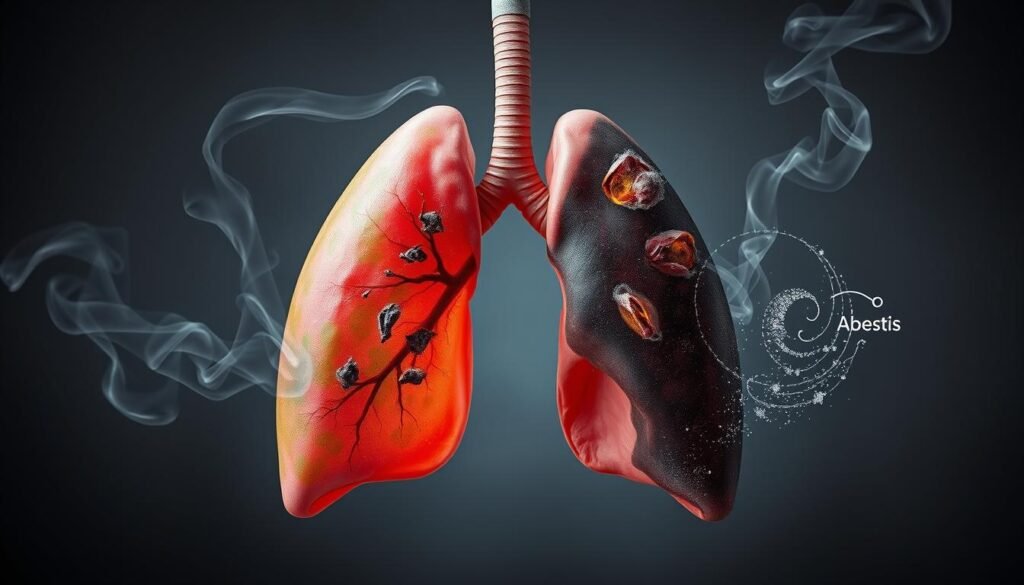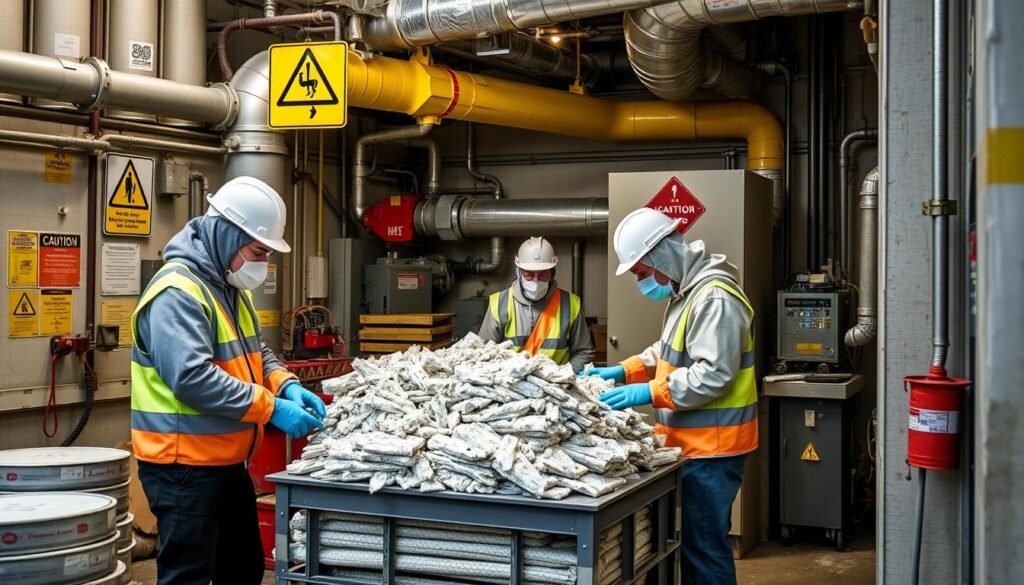Individuals who smoke harm their lungs and raise their asbestos risk. This makes them 28 times more likely to die from lung cancer than the average person. This shows how crucial it is to manage the increased risk from smoking and asbestos. Smoking and asbestos each pose dangers on their own, leading to lung cancer and asbestosis.
Smoking and asbestos together can make lung problems worse. This can lead to severe health issues. Stopping smoking is key for those exposed to asbestos. It can lessen harm and help lungs heal. The American Lung Association has programs to help quit smoking, improving life quality.
Knowing the dangers of smoking and asbestos helps people protect their health. Making changes, talking to doctors, and finding community help is vital in managing these risks.
Key Takeaways
- Asbestos exposure can worsen symptoms of asbestosis and increase its progression rate.
- Quitting smoking can improve lung health in those exposed to asbestos.
- Support programs like those from the American Lung Association can assist in smoking cessation efforts.
- Proper nutrition, adequate sleep, and regular exercise are fundamental for managing asbestosis.
- Patients with asbestosis should discuss their needs with healthcare providers for effective management.
Understanding Asbestos and Its Health Risks
Asbestos is a group of minerals that’s found in nature. It’s especially dangerous when its fibers get into the air. This can happen during building work, tearing down buildings, or handling materials that contain asbestos. Knowing where asbestos comes from and its risks is very important. It helps us protect our health and avoid diseases like lung cancer and mesothelioma.
Definition and Sources of Asbestos Exposure
People can come into contact with asbestos in certain jobs. This is common in construction, shipbuilding, and car repair. Diseases from asbestos might not show up for 20 to 30 years, which makes them hard to spot. Even people who don’t work directly with asbestos can be in danger. An example is the rescue workers from the World Trade Center attacks.
Health Risks Associated with Asbestos
Being around asbestos is very risky for your health. If you breathe in asbestos fibers for a long time, you could get seriously sick. Diseases include asbestosis, lung cancer, and mesothelioma. Asbestosis scars your lungs and shows up decades after you’re first exposed. Getting ill depends on how much and how long you’re exposed, and if you smoke.
Lung cancer and mesothelioma are closely linked to asbestos. The International Agency for Research on Cancer says asbestos is a cancer-causing substance. There’s no safe amount of it. Mesothelioma usually happens because of work exposure. The chance of lung cancer goes up if you’ve been exposed to asbestos and if you smoke. Knowing this and taking steps to avoid asbestos can make a big difference for your health.
The Dangers of Smoking on Respiratory Health
Smoking poses significant threats to respiratory health. It leads to severe illnesses that can cause a preventable death. These illnesses damage lung function and make breathing hard. Recognizing these dangers is key. It helps us push for better health actions and stop smoking.
Smoking as the Leading Cause of Preventable Death
Smoking is the top cause of preventable death in the U.S. Up to 90% of lung cancer cases are due to smoking. Besides lung cancer, tobacco use leads to other serious lung diseases. This stresses the importance of quitting smoking to get better health outcomes.
How Smoking Harms Lung Function
Smoking badly damages lung function. Smoking toxins harm the cilia, which are needed to clean our lungs. This causes long-term swelling and lowers the lungs’ working ability. Smokers also face a higher chance of getting COPD and other lung issues. Quitting smoking protects our lungs and cuts down these risks.

| Health Outcome | Smokers | Non-Smokers |
|---|---|---|
| Risk of Lung Cancer | Up to 90% attributed to smoking | Minimal |
| Incidence of COPD | High | Low |
| Effect on Lung Function | Severely impaired | Normal |
| Risk of Preventable Death | Leading cause | Low |
Connecting Smoking and Asbestos Exposure
When smoking and asbestos exposure combine, they pose serious health risks, especially for our lungs. This mix increases the chance of lung cancer and asbestosis. Knowing how these risks work together shows why it’s crucial to avoid them and stay aware of our health.
Supra-Additive Risks of Lung Cancer
Studies have found that smoking and asbestos together greatly boost the risk of lung cancer. People exposed to both have a 28 times higher chance of getting lung cancer compared to those who neither smoke nor face asbestos exposure. These substances damage lung cells, causing cancer over time. Furthermore, the specific type of asbestos fibers can affect how deep they get into the lungs, raising the risk even more.
Increased Severity of Asbestosis Symptoms
Asbestosis is a lung disease from inhaling asbestos fibers, and smoking makes it worse. Smokers with asbestosis have more trouble breathing and their disease progresses faster. This makes it harder to manage their respiratory health. Symptoms like coughing and chest pain get worse, lowering life quality. Treating asbestosis in smokers is challenging due to the combined lung damage from both smoking and asbestos.

| Factor | Impact on Lung Cancer Risk | Impact on Asbestosis Symptoms |
|---|---|---|
| Smoking | Increases likelihood of lung cancer, especially when combined with asbestos | Exacerbates cough and breathlessness |
| Asbestos Exposure | Directly linked to lung cancer development and other cancers | Causes chronic lung disease with significant symptoms |
| Combined Effects | Risk multiplies significantly, leading up to a 28-fold increase | Worsens disease progression and symptoms |
Managing the Increased Risk from Smoking and Asbestos
To lower the risks from smoking and asbestos, we need good smoking stop plans and health care that prevents problems. These actions make you healthier and help your community too.
Smoking Cessation Strategies
Quitting smoking is key for people who’ve been near asbestos. The American Lung Association offers help for quitting. Using a mix of therapy, nicotine replacements, and groups can really help people quit.
- Establish a quit date and prepare for it.
- Identify triggers that lead to smoking and develop strategies to avoid them.
- Consider prescription medications that help reduce cravings.
- Engage in physical activities to manage stress and prevent weight gain.
Preventive Healthcare Recommendations
It’s vital to add preventive healthcare to lower risks from smoking and asbestos. Getting regular checks can spot problems early. This helps treat issues swiftly. Preventive care should include:
- Annual respiratory health check-ups.
- Vaccinations to protect against respiratory infections.
- Monitoring for any respiratory symptoms.
- Education on maintaining a safe living environment, particularly in older homes where asbestos may be present.
By using these strategies, you can greatly lower health risks from smoking and asbestos. Quitting smoking not only helps you but also has a positive impact on people around you.
Occupational Health and Safety Measures
Workers exposed to asbestos need to stay safe. Having strong safety measures can cut down the dangers of asbestos. This protects both the workers and their work areas.
Precautions for Workers Exposed to Asbestos
It’s important for employers to keep their workers safe from asbestos. They should take steps like:
- Regular monitoring of air quality to spot asbestos fibers at work.
- Use of personal protective equipment (PPE) including masks, gloves, and special clothes.
- Safe handling procedures when taking buildings apart or putting them back together.
- Immediate reporting of asbestos signs to bosses so they can handle it quickly.
Importance of Training and PPE
Learning about safety is key, especially with asbestos dangers. Workers need training on:
- The health effects of asbestos, like lung cancer risks.
- How smoking and asbestos can make cancer risks worse.
- How to use safety gear properly for the best protection.
When workers know more and have the right tools, companies create a safe culture. Keeping up with education and OSHA rules helps protect everyone from job dangers in the long run.

| Precaution | Importance |
|---|---|
| Air Quality Monitoring | Finds dangerous asbestos fibers to stop exposure. |
| Personal Protective Equipment | Lowers direct asbestos contact, lowering health risks. |
| Safe Handling Procedures | Keeps asbestos fibers from spreading during work tasks. |
| Health and Safety Training | Tells workers about dangers and how to stay safe. |
Environmental Hazards and Asbestos
Asbestos is a big problem because it’s everywhere in our surroundings. It can get into homes and communities from old building materials falling apart or natural sources. Knowing about these dangers is vital. They can hurt our health if we’re exposed for a long time.
How Asbestos Enters Homes and Communities
When buildings get old, asbestos fibers can get into the air. This happens when materials that have asbestos start to break down. Some common ways this happens include:
- Deteriorating insulation in older homes
- Cracking or damaged roofing and siding
- Disturbance of soil contaminated with natural asbestos deposits
Often, we don’t notice these materials, which means people can be exposed without knowing. As buildings age and wear down, the danger of being exposed to asbestos goes up.
Long-term Effects of Asbestos in the Environment
Being exposed to asbestos for a long time can lead to serious health issues. These issues might not show up until 20 to 50 years after someone is exposed. Some important points include:
- Symptoms may not show up for many years, making it hard to know you’re sick.
- If you smoke and are exposed to asbestos, your risk of getting sick is even higher.
- The more you’re exposed to asbestos, and the longer the exposure, the greater your risk.
We need to take action to protect our communities from asbestos. This means teaching people about the risks and how to avoid them. It’s important for everyone’s health.
| Health Risks | Latency Period | Common Sources |
|---|---|---|
| Lung Cancer | 20 to 50 years | Insulation, roofing |
| Mesothelioma | 30 years or more | Building materials |
| Asbestosis | 15 years or more | Contaminated soil |
Public Awareness Campaigns on Smoking and Asbestos
Raising awareness about smoking and asbestos is key to community health. These campaigns teach the risks of smoking and asbestos. They aim to inform and encourage safer behaviors.
They reach people through schools, workplaces, and communities. This way, important health information and resources get to everyone.
Educational Initiatives to Reduce Exposure Risks
Educational efforts are vital in showing the dangers of smoking and asbestos. Programs are designed to connect with different people effectively. This helps everyone understand the risks better.
For example, schools teach students about the harms of smoking. Workplaces may offer training on avoiding asbestos. Such initiatives encourage smarter, health-focused decisions.
Community Support for Smoking Cessation
Community support is crucial for quitting smoking. Health organizations offer workshops to share quitting tips. They provide advice, encouragement, and counselling services.
Thanks to public awareness, more people join these programs. This boosts participation and improves public health over time.
| Type of Initiative | Target Audience | Focus Areas |
|---|---|---|
| School Programs | Students | Smoking dangers, asbestos awareness |
| Workplace Training | Employees | Asbestos safety, smoking cessation strategies |
| Community Workshops | General Public | Support for quitting smoking, health resources |
Best Practices for Reducing Asbestos Exposure
Keeping your home safe means knowing how to manage asbestos. This is vital in older homes that might have asbestos materials. It’s important to regularly check and assess these old materials for asbestos. Taking the right safety steps can limit risks during home repairs or updates.
Home Safety Measures
By applying certain safety measures, you can cut down the risk of being exposed to asbestos. What to do includes:
- Looking for asbestos materials regularly.
- Cleaning with wet methods to keep dust down, instead of dry cleaning or vacuuming.
- Keeping the air moving where asbestos could be stirred up.
- Safely storing asbestos materials when you can’t get rid of them right away.
To be completely safe, talk to asbestos management professionals for repair work involving asbestos. They make sure everything is done right to protect everyone at home and on the job from danger.
When to Consult Professionals for Asbestos Management
Knowing when to call the experts for asbestos is crucial. You should especially consider it in these situations:
- When you’re doing updates that disturb materials.
- If you find asbestos that could crumble and release fibers into the air.
- When you’re not sure how to safely remove asbestos yourself.
- If there’s a chance someone could have been exposed to asbestos after an accident.
Hiring certified professionals is a smart move. They reduce the risks linked with asbestos and make sure safety rules are followed. Since asbestos fibers can float in the air a long time, expert help is essential to keep your home safe.
Conclusion
Managing the risks from smoking and asbestos is key to better respiratory health. These factors play a big role in lung diseases, including lung cancer. Knowing how smoking and asbestos interact helps us and our communities lower these risks.
Stopping smoking is critical in the fight against lung cancer. By putting in place strong smoking cessation programs, we can greatly reduce serious health issues. People working in environments with asbestos should follow safety measures to protect themselves from lung cancer.
It is vital to stay up-to-date with the hidden risks of diseases from asbestos. As we learn more from research, staying aware and taking preventive steps is important. For further information on how allergies and lung cancer are connected, check out this resource.